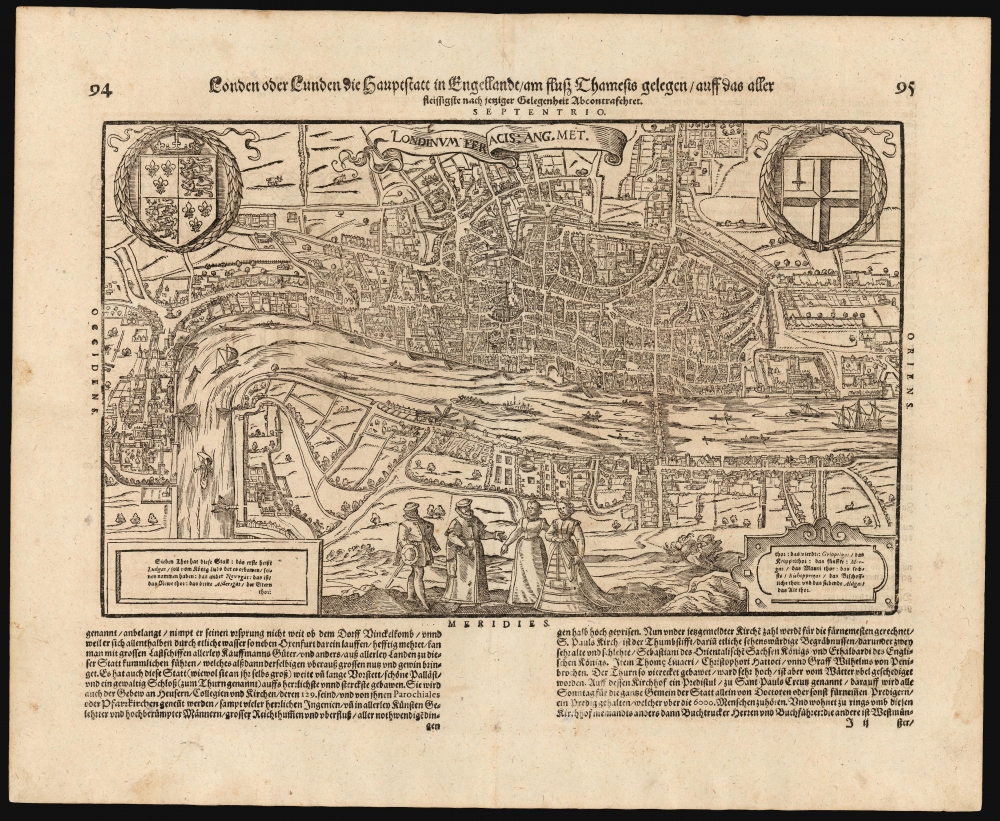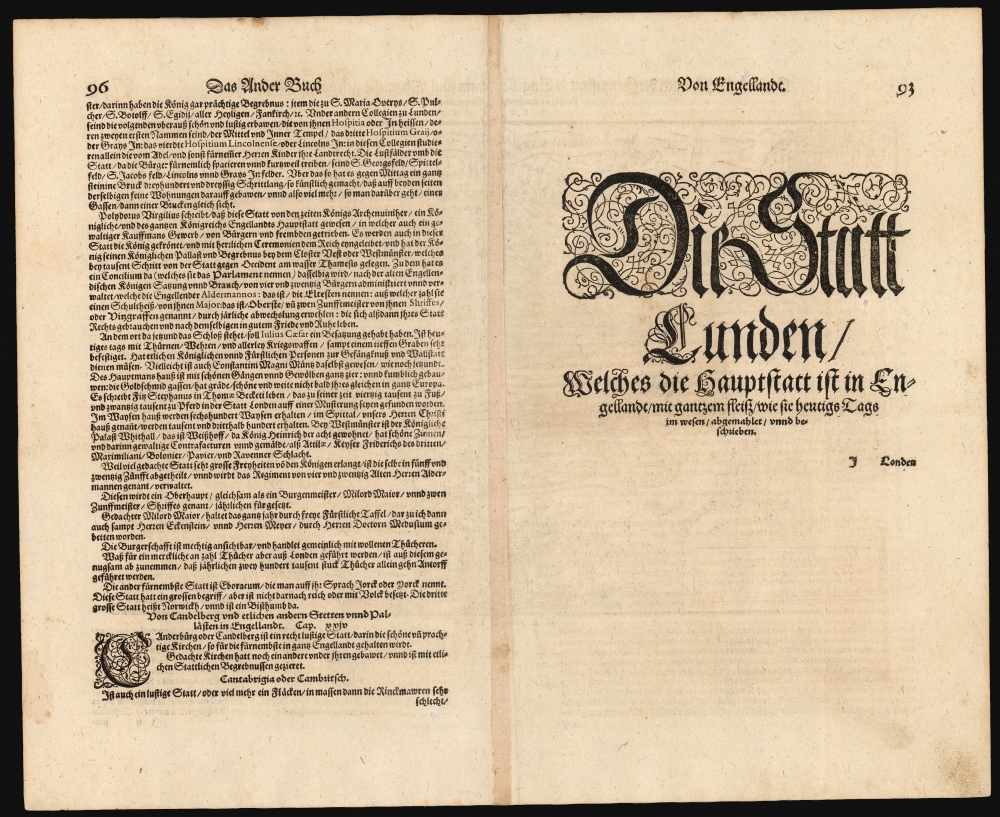This item has been sold, but you can get on the Waitlist to be notified if another example becomes available, or purchase a digital scan.
1598 Münster View of London, England
London-munster-1598
Title
1598 (undated) 11.5 x 15 in (29.21 x 38.1 cm)
Description
A Classic, Decorative Woodcut
Modeled on Georg Braun and Franz Hogenberg's 1572 plan, the city here is laid out as a plan, but the buildings and surrounding landscape are presented in elevation - thus giving the impression of a bird's-eye view, even to the extent of detailing gardens and showing bustling river traffic. Also, as with the Braun and Hogenberg, the anonymous formschneider has included four figures in the foreground: a nobleman and woman, with their attendant maid and footman (he, armed with a sword and buckler), each dressed in the styles of the period appropriate to their positions.A Late Addition
From its first edition, Münster's Cosmographia included a text describing England and the British Isles. The shortness of that section indicated that for many years, Münster didn't know much about islands. In the 15th century, the British Isles were, of European lands, nearly as remote and unknowable as Scandinavia. When, in 1550, Münster was able to get firsthand reports of those islands, they came via Scotsman Alexander Ales, and so Cosmographia included a depiction of Edinburgh well before one of London.The Early London Plans
The first single-sheet plan of London was in Cologne in 1572 by Georg Braun and Franz Hogenberg. The second acquirable London plan was a woodcut executed for Francois de Belleforest's 1575 French translation of Münster. No other acquirable plan of London was issued until this one in 1598.It might be supposed that the appearance of an updated Cosmographia such as Belleforest's signaled to its publishers that Münster's hoary work, with its 35-year-old maps, might be due for an overhaul. In 1588, Sebastian Petri began publishing the work with new maps and views. Surprisingly, Petri had little to add for Britain: that section in the 1588 edition is substantially the same as the one from 1578. Not until a decade had passed would the new edition include this image - with the result that only the 1598, the 1614, and the 1628 editions of Cosmographia contain it.
The Source Plan
In the above iterations, this remained the final depiction of London made before the Great Fire of 1666. (Howgego notes that the Great Fire and the problems attendant to land ownership and rebuilding led to the first proper surveys of the city.) It is an image of a still older London: St. Paul's Cathedral still sports the tall, pointed spire, which was destroyed in 1561. The 1572 plan was based on an earlier work that has not survived in completion: a now-lost 15-sheet plan of the city, the so-called 'copperplate map' of which only three plates now survive. The authorship of the 'copperplate map' is not known. It has been speculated that the Hansa in London played some part in its production, even commissioning the work - resulting in the laudatory paragraph to the Hansa that survives on the Braun and Hogenberg. By the time this plan was made, the Hansa had lost their grip on London's trade, and indeed, Elizabeth I ordered the Hansa out of London completely by 1597.Publication History and Census
This woodcut was executed by an anonymous artist for inclusion in the 1598 Sebastian Petri edition of Münster's Cosmographia. Consequently, it appeared in only three editions of the work, making it among the rarest of the woodcuts from Münster's book and one of the rarest plans of London. The present example conforms typographically to the 1614 German-text edition of the book. Only one example of the separate plan is recorded in OCLC, in the collection of the Hergozin Anna Amalia Bibliothek Klassic.CartographerS
Sebastian Münster (January 20, 1488 - May 26, 1552), was a German cartographer, cosmographer, Hebrew scholar and humanist. He was born at Ingelheim near Mainz, the son of Andreas Munster. He completed his studies at the Eberhard-Karls-Universität Tübingen in 1518, after which he was appointed to the University of Basel in 1527. As Professor of Hebrew, he edited the Hebrew Bible, accompanied by a Latin translation. In 1540 he published a Latin edition of Ptolemy's Geographia, which presented the ancient cartographer's 2nd century geographical data supplemented systematically with maps of the modern world. This was followed by what can be considered his principal work, the Cosmographia. First issued in 1544, this was the earliest German description of the modern world. It would become the go-to book for any literate layperson who wished to know about anywhere that was further than a day's journey from home. In preparation for his work on Cosmographia, Münster reached out to humanists around Europe and especially within the Holy Roman Empire, enlisting colleagues to provide him with up-to-date maps and views of their countries and cities, with the result that the book contains a disproportionate number of maps providing the first modern depictions of the areas they depict. Münster, as a religious man, was not producing a travel guide. Just as his work in ancient languages was intended to provide his students with as direct a connection as possible to scriptural revelation, his object in producing Cosmographia was to provide the reader with a description of all of creation: a further means of gaining revelation. The book, unsurprisingly, proved popular and was reissued in numerous editions and languages including Latin, French, Italian, and Czech. The last German edition was published in 1628, long after Münster's death of the plague in 1552. Cosmographia was one of the most successful and popular books of the 16th century, passing through 24 editions between 1544 and 1628. This success was due in part to its fascinating woodcuts (some by Hans Holbein the Younger, Urs Graf, Hans Rudolph Manuel Deutsch, and David Kandel). Münster's work was highly influential in reviving classical geography in 16th century Europe, and providing the intellectual foundations for the production of later compilations of cartographic work, such as Ortelius' Theatrum Orbis Terrarum Münster's output includes a small format 1536 map of Europe; the 1532 Grynaeus map of the world is also attributed to him. His non-geographical output includes Dictionarium trilingue in Latin, Greek, and Hebrew, and his 1537 Hebrew Gospel of Matthew. Most of Munster's work was published by his stepson, Heinrich Petri (Henricus Petrus), and his son Sebastian Henric Petri. More by this mapmaker...
Heinrich Petri (1508 - 1579) and his son Sebastian Henric Petri (1545 – 1627) were printers based in Basel, Switzerland. Heinrich was the son of the printer Adam Petri and Anna Selber. After Adam died in 1527, Anna married the humanist and geographer Sebastian Münster - one of Adam's collaborators. Sebastian contracted his stepson, Henricus Petri (Petrus), to print editions of his wildly popular Cosmographia. Later Petri, brought his son, Sebastian Henric Petri, into the family business. Their firm was known as the Officina Henricpetrina. In addition to the Cosmographia, they also published a number of other seminal works including the 1566 second edition of Nicolaus Copernicus's De Revolutionibus Orbium Coelestium and Georg Joachim Rheticus's Narratio. Learn More...
Source
Munster's methodology in Cosmographia is notable in particular for his dedication to providing his readers with direct access to firsthand reports of his subjects wherever possible. Many of the maps were the result of his own surveys; others, the fruit of an indefatigable letter writing campaign to scholars, churchmen and princes throughout Europe, amicably badgering them for maps, views, and detailed descriptions of their lands. For lands further afield than his letters could reach, Munster relied on the best that the authorities of northern European scholarship could offer: he was well familiar with the work of Waldseemuller and other geographers of the early 16th century, and was well connected with the best geographers of his own generation. A disproportionate number of the maps of Cosmographia show contemporary geographical knowledge of the their respective areas for the very first time: The first map to show the continents of the Western Hemisphere; the first map to focus on the continent of Asia; the first modern map to name the Pacific Ocean; the first map to use a key; the first modern map of the British Isles and so on. Even in cases where earlier maps exist, Munster's works very often remain the earliest such acquirable by the collector.




